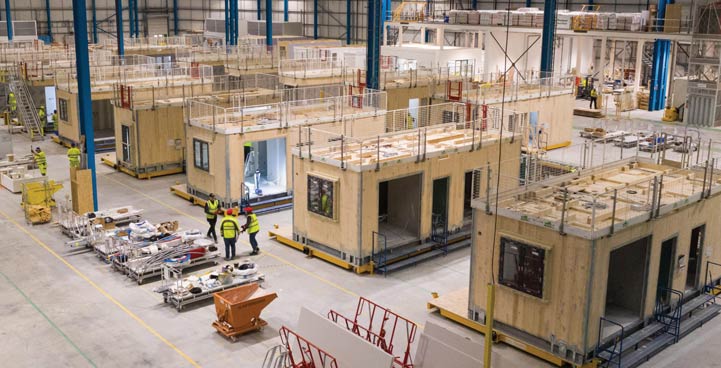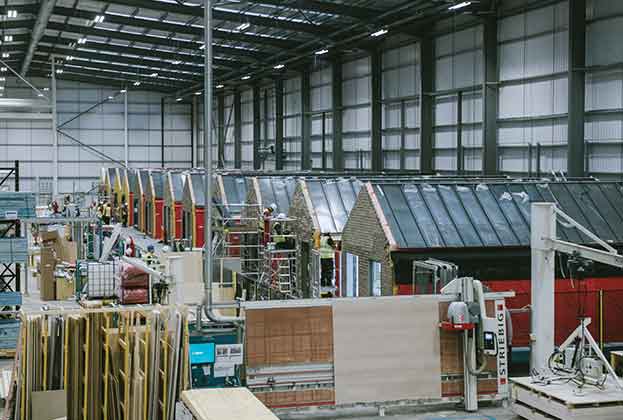Up to 40 factories needed across the country to meet construction demand
This publication has referred to ‘modular housing factories’ however, in the most part, the buildings being used for construction are often warehouses designed with retail logistics and distribution in mind. The logistics warehouse benefits from many features which facilitate the assembly of modular housing components such as ample height, access doors for deliveries, proximity to the main road network for onward distribution and the availability of large energy supplies to power tools and machinery.

Photo Legal & General Modular Homes
Industrial impact?
Clearly there are market and political drivers which over the next decade will determine the growth of modular housing in the UK. However any increase in delivery of modular homes needs to be met with the delivery of construction capacity which will therefore result in more warehouse space being leased or purchased by modular housing companies.
Based upon our analysis of the existing market we have identified that 150 sq ft of additional factory space is required per each additional unit that is delivered by MMC. The analysis also demonstrates that the average size for a factory has settled around 150,000 sq ft after an number of significantly larger units were taken in the early stages of this new market emerging.
We have mapped out four potential scenarios over the next decade which show MMC increasing its proportion of the market by 5% and 10% but also the industry as a whole increasing its annual delivery to 300,000 units.
In our most optimistic scenario an additional 40,000 units are delivered annually by MMC. This results in the need for an additional 40 factories across the country which total 6 m sq ft. If all of this capacity was required imminently then it would increase the average amount of transactions for warehouse units over 100,000 sq ft by 37%.
More likely however is that units will be taken over a longer period of time as demand from modular house builders ebbs and flows.
Bespoke or second hand?
The availability of warehousing is historically low, as demand has spiked as online retail has grown. Indeed vacancy rates stand at just 6.8% compared with levels around 15% almost a decade ago.
Our analysis shows that, to date, the majority of factory space for MMC is actually second hand logistics warehousing which has been retrofitted to the needs of the construction company. However, as the industry matures it is likely that construction efficiencies will occur that will warrant the delivery of a more bespoke facility.
In this instance the most likely route for delivery will be to lease space for a ‘Build to Suit’ (BTS) unit from a mainstream logistics and industrial developer. However, this may have cost implications for the factory operator as the average lease length for a BTS unit in 2019 was 18 years, compared with 12 years for a second hand unit.
A public sector-backed industry?
A key enabler of MMC growth will be the award of contracts from local authorities and housing associations to deliver social housing within their boundaries. From a logistics and industrial developer perspective this has the potential to make MMC companies more attractive as potential tenants as their sales pipeline is effectively backed by the state.
For investors in the logistics sector this income is often hard to come by and any buildings with modular house builder as the tenant could therefore become very attractive investments.
Read the articles within Spotlight: Modern Methods of Construction below.
.jpg)
